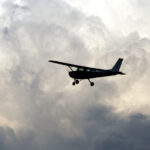What to do when your flight plan fails and lives are at risk
’ve always been jealous of helicopter pilots. I thought they had it made – in all situations if they didn’t like the way things were going they could always just land in a field or on a road, right? When their carefully thought-out flight plan takes them through lowering ceilings, or stronger than forecast headwinds, or a line of storms….can’t they just find a landing spot and set her down?
As one of the only fixed wing pilots in a mostly helicopter EMS operation, I’ve heard the stories. The time an unexpected snow squall forced a pilot to land in a mall parking lot WITH the patient on board. Or when a chip light came on and the pilot elected to land safely in a field and wait for the mechanic to drive out to his location.
So then why are there so many helicopter accidents? Why do pilots who know they are flying into lowering ceilings and rising terrain not choose to land?
Maybe they keep going because MOST of them make it to their destination. Maybe individual pilots have had close calls, but they found their way home, so it’s possible that they think it won’t happen to them. And then they do it again. Sometimes they get lucky and sometimes they don’t.
Matt Zuccaro, former president of the Helicopter Association International, recently passed away, but left behind his efforts to dramatically improve helicopter safety and reduce the overall helicopter accident rate. His signature effort was HAI’s “Land and Live” campaign.
Matt urged pilots to “land the damn helicopter” rather than continue to fly in problematic and potentially unsafe conditions. He believed that in most accidents, the pilot had prior knowledge that something was wrong. When the cause was fuel starvation, most pilots were aware of the low fuel situation; with weather related accidents, pilots knew they were in less than ideal conditions; if the problem was mechanical, most pilots had alerts by warning systems or abnormal noises/vibrations. Even if the pilot had a medical issue, he/she is usually aware of substandard performance or diminished abilities. With all of this in mind, and assuming the flight is not over rocky, mountainous terrain or a large body of water, why don’t pilot’s just land? Why not take advantage of one of the most unique and valuable capabilities of vertical flight and land the damn helicopter.
This simple act would break the accident chain in most helicopter crashes. The Helicopter Association International takes this very seriously and wants their pilots to take a pledge to show that they are all-in with safety. The following link will bring you to the pledge page, where you can take the pledge, submit your information and receive a certificate showing your dedication to safety:
https://www.rotor.org/initiatives/land-and-live/pledge
THE PILOTS PLEDGE TO LAND AND LIVE
“I affirm that my highest priority is the safety of my passengers, my crew, my aircraft, and the people we fly over. In order to maintain their safety, I pledge to keep safety/precautionary landings as a readily available option and when, in my best judgment, the wisdom of continuing a flight is uncertain, to make a controlled safety/precautionary landing before an emergency landing becomes necessary.”
A safe flight starts with a good flight plan, but we all know that circumstances change and a backup plan is always a good idea. Take the pledge and do your part to ensure the safety of your passengers and yourself. There is a reason why helicopters can hover and land on a dime. It’s why all your fixed wing friends are envious. You might as well use it when you need it!
RELATED READING
RELATED CTS TRAINING









